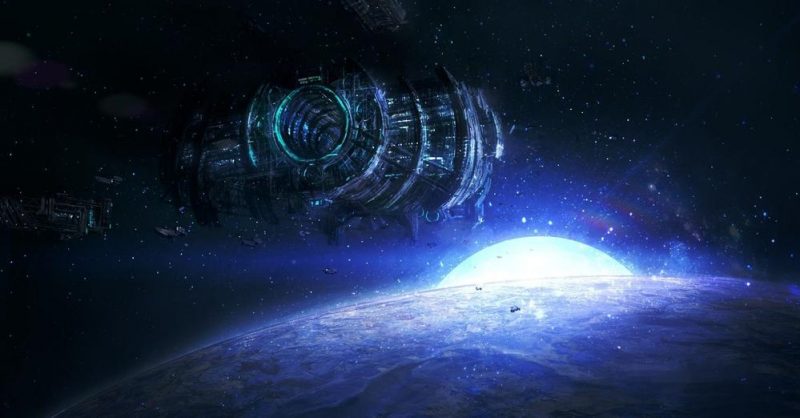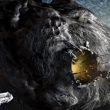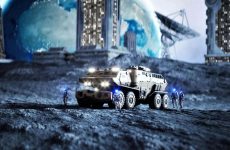In almost 60 years of NASA’s so-called space exploration it has never been able to offer us a single genuine photograph of the Earth from space… No real one!? Even though we’ve had good, high-resolution cameras for almost 100 years, NASA has never taken a true picture of our planet, Earth.
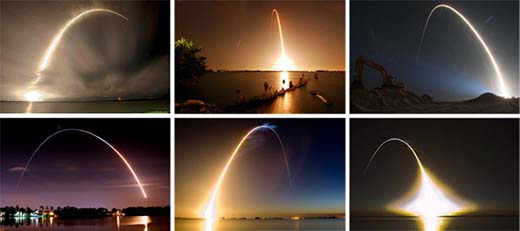
By their own admission, all the images we see are composites, paintings, or computer generated images. Why is this?
The answer, horror of horrors, could be that NASA has never been in space, or at least not far enough from Earth to get the entire planet in the picture.
Houston, we have a problem…
Above, we’ve been able to see some photos of NASA’s space shuttle rockets and launches , using long exposures to allow us to follow the vehicle for much longer than we would see during normal TV coverage.
Do you notice something strange in the trajectories? Well, I’m not a genius, but according to my Flash Gordon comics rockets are supposed to go up, not up and then immediately back down…or somewhere in the sea!
Houston, we have another problem…
Circling the Earth, beginning at an altitude of 1,000 miles (1,600 kilometers) and extending an additional 25,000 miles (40,233 kilometers), are deadly bands of radiation called the Van Allen radiation belts, which could fry instrumentation at board and make any foolhardy astronaut sick enough by passing through them.
So how did the Apollo missions get through the Van Allen belts back in the 1960s, when NASA is currently struggling with ways to protect its astronauts on their (supposed) next trip to Mars?
Three naughty schoolboys
Here’s something for anyone who still believes we went to the Moon. It’s the bristling convergence at the Apollo 11 Press Conference immediately after the astronauts’ return to Earth.
Keep in mind that these three Masons, sorry astronauts, sorry men have supposedly just returned from the greatest adventure in the history of mankind. These guys are national heroes of the USA. They have fulfilled every kid’s dream.
We hope you are excited, excited, and buoyed up that you survived the journey, and walked on the moon! And yet they are strangely muffled, nervously watching their teleprompters, and each other, as they answer reporters’ questions. “Stars? What stars…? «
At 01:04:42, at the Apollo 11 Press Conference held after the astronauts returned, Neil Armstrong was asked if he remembered seeing any stars in the lunar sky, a subject the crew was apparently asked. to avoid since the correct astrological positions of the constellations were too difficult to simulate on the false lunar backgrounds.
Armstrong then erroneously responds with “I don’t remember,” to which Aldrin winces at his mistake (as if one might forget an important detail that they witnessed firsthand in their supposedly universally unique experience).
To help Armstrong get over being shot at for this difficult question, crew member Michael Collins offered assistance by interjecting, saying “I don’t recall seeing any.”
The problem is, he forgot he wasn’t there! (It was Buzz Aldrin who supposedly walked the surface of the moon with Armstrong , not Collins!)
Has NASA been nowhere?
What if it’s not possible to send things into space, even put things into Earth’s orbit? There are three serious obstacles to being able to put things into space and getting them to stay there, and these must be accommodated within our “reality frame” so that we can determine what is real and what is NASA’s reality.
1. The Thermosphere
Forget the deadly Van Allen radiation belts, which stretch thousands of miles around Earth, the main reason nothing has ever gone into space is the Thermosphere. This atmospheric layer begins at about 50 miles (80 km) high, where temperatures begin to rise up to the Kármán line which reaches 62 miles (100 km).
Beyond this point, the heat increases dramatically, rising rapidly to 125 miles (200 km), where temperatures can reach 2,500 °C.
For reference: the oven in your kitchen can reach 240°C maximum. A crematorium reaches 1,000°C, and a blast furnace for melting iron can reach as high as 2,300°C.
NASA uses aluminum, magnesium, titanium, and epoxy-graphite composite materials to build its spacecraft, all of which would melt in these high temperatures of the thermosphere.
Both aluminum and magnesium melt at 660°C, titanium at 1668°C. While graphite has a high melting point (5500°C), it is also an excellent conductor of heat, although your spacecraft will most likely disintegrate long before the astronauts are cooked to ashes! Humans cannot survive exposures above 70°C.
2. The Orbiting Mechanism
What things float in space when they are beyond 100 km from Earth? Does gravity magically stop affecting objects at this distance?
The official answer is that above 100 km objects are essentially in free fall, but if something is traveling fast enough laterally, like the space shuttle at 28,000 km/h, then this speed will cause the object to fall constantly. along the convex curve of the Earth, thus never reaching the ground – hence keeping itself ‘in orbit’.
This is known as the theory of gravity, the extrapolation of an idea originally conceived by Isaac Newton in the 17th century, and today increasingly rejected by more clear-headed people who have their feet firmly on the ground.
In fact Newton himself, after some contemplation, thought of the practical application of his ridiculous theory, as he put it in a letter to a friend, Richard Bentley in 1692:
“That gravity should be innate, inherent and essential to matter, so that one body can act on another at a distance through a vacuum without the mediation of anything else, by and through which its action and force can being transmitted from one to another, is to me such an absurdity that I believe that no man, who has in philosophical matters a competent faculty of thought, can ever fall into it. –
Isaac Newton
The idea that a body with sufficient mass can exert an attractive force on another, as a planet is supposed to have on its moon (astronauts and spacecraft), has never been demonstrated or proven.
An increasing number of physicists are questioning whether gravity exists at all.
3. The abundance of counterfeiting
If NASA really has put things into orbit, sent men to the Moon, and launched the probes into outer space, then why is there so much secrecy, subterfuge, and falsification about it?
And the biggest damnation of all, why can’t NASA produce a simple genuine photograph of the Earth from space?
The famous “Blue Marble”
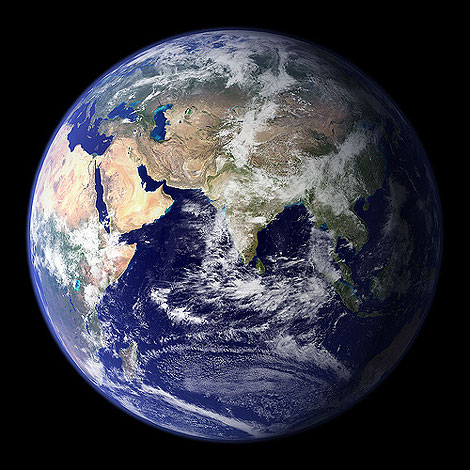
Beautiful, isn’t it? Well, it’s fake! This iconic image (above) was pieced together from alleged “satellite” data and then photoshopped so crudely that you’ll see it if you click on the image.
The discovery of duplicate clouds has led to accusations that not only is the 2002 image (blue marble II) a fake, but the original Apollo 17 image (blue marble blue I) was probably a fake as well.
That, in turn, has led some to question whether everything NASA did and said was false.
NASA says: This spectacular image of the “blue marble” is the most detailed true color image of the entire Earth to date.
Using a set of satellite-based observations, scientists and visualizers stitched together months of observations of the land surface, oceans, sea ice, and clouds into a seamless, true-color mosaic of every square kilometer of our planet.
It’s all about expectations, says NASA artist:
“The last time someone took a picture from above low Earth orbit that showed a full hemisphere (one side of a globe) was in 1972 during Apollo 17. NASA’s Earth Observing System (EOS) satellites ) were designed to perform a health check on the Earth. By the year 2002, we finally had enough data to take a snapshot of the entire Earth. That’s how we did it.”
“The hardest part was creating a flat map of the Earth’s surface using four months’ worth of satellite data. Reto Stockli, now at the Federal Office for Meteorology and Climatology, did much of this work.”
“So we wrapped the flat map around a sphere. My part was to integrate the surface, clouds, and oceans to match people’s expectations of what the Earth looks like from space. That ball became the famous Blue Marble.” – Robert Simmon, NASA artist
All very fascinating, but wouldn’t it be easier to just take a picture — just a picture — from one of its 3,000-plus satellites? Apparently not.
The good folks at NASA tell us that the only ‘photos’ of the entire Earth were taken during the Apollo 17 mission. The fact that this mission, along with all other Apollo missions, never actually left Earth, goes to make finding these photos problematic.
Yes, but NASA has satellites. It is not like this? I mean, NASA has been sending objects into space for years, right? TRUE? How can we know?
The problem is that this US government agency, with its multi-million dollar budget, has a monopoly on all space artifacts.
The only way to know for sure would be to go there ourselves, independent of NASA, and have a look around. This is exactly what Sir Richard Branson attempted in 2014.
Will there be a conclusion to make? By conclusion do we mean a judgment or determination about the reality of NASA’s so-called “space program”? Is that what we want, even if it risks being presented with a worst case scenario where it has all been a big lie?
Because if, as the facts seem to indicate, NASA hasn’t even been in orbit (whatever that is), then we have to get used to a whole new reality, without moon landings, satellites, Hubble telescope, International Space Station, or space missions. Mars.
If, worse yet, one of the reasons nothing is in orbit is because gravity doesn’t exist, then what’s stopping us from ditching NASA’s Earth-Marble?




